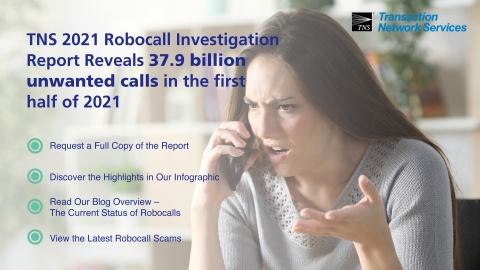RESTON, Va.--(BUSINESS WIRE)--Americans received 80 billion unwanted robocalls over the past 12 months, but less than 5% of high-risk calls originated from the top six US carriers (AT&T, CenturyLink, Charter, Comcast, T-Mobile and Verizon) -- continuing a shift in robocall activity from Tier-1 carriers to smaller VoIP providers. The findings come from the Seventh Edition of Transaction Network Services (TNS) Robocall Investigation Report released today.
The TNS 2021 Robocall Investigation Report is a bi-annual update of key robocall trends drawing from an analysis of 1.3 billion daily call events across hundreds of carriers. The current report looks at data trends for the 12-month period between June 2020 and June 2021 for two types of negative robocalls: high-risk robocalls (scam/fraudulent calls which attempt to acquire call recipient personal information and/or money) and nuisance robocalls (which are not of malicious intent or negligent non-compliance).
The Report reveals that following a brief dip in unwanted calls during the COVID-19 lockdown, unwanted calls increased by 6% to a total of 37.9 billion in the first half of 2021 compared to the first six months of 2020. Key findings from the Report include:
Neighbor Spoofing Plagues Americans
Neighbor spoofing using low-volume spamming (spreading a very low volume of calls across a very large set of telephone numbers to avoid analytics engines) is a tactic employed by bad actors. Use of same area code saw a 127% increase and use of same area code and prefix saw an increase of 52% using this low-volume spamming technique.
Scammers Shift to VoIP Networks
With Tier-1 high-risk call volume down, robocallers are turning to VoIP networks, which now account for the largest share of unwanted calls. Sixty-six percent (66%) of all high-risk calls and 61% of all nuisance calls originate from VoIP telephone numbers – representing the largest two sources of these unwanted calls. The percentage of unwanted calls on VoIP networks increased to 38% in the first half of 2021, rising from 23% in the first half of 2020.
Robocallers Doubling Down on Home Wireline Phones
While much of the robocall attention centers around mobile phones, 41% of inter-carrier calls placed to wireline numbers in the first half of 2021 were unwanted compared to 21% of calls to wireless numbers. The fact that wireline numbers are now approximately twice as likely to receive an unwanted call as wireless numbers is a reminder that robocalls are not simply a mobile problem.
STIR/SHAKEN Adoption Growing with Tier-1 Carriers
Government and carrier efforts to advance STIR/SHAKEN implementation have paid dividends. Tier-1 carriers have deployed the call authentication framework with more than 50% of the total calls in June signed and validated, up from 35% at the beginning of the year. And while the top six US carriers account for three-quarters of all inter-carrier traffic, 95% of high-risk calls originate from non-Tier-1 service providers.
Consumers Eager for Branded Calling
According to a TNS survey earlier this year, 77% of consumers never answer phone calls from numbers they do not recognize, but 63% of survey respondents would answer a call if caller ID displayed the logo of a brand they recognized. While Caller ID or Call Protection services are already used by 54% of consumers, the survey data indicated richer incoming call context via enterprise branded calling solutions can improve answer rates while protecting call originator brands.
Consumers Fed Up with Robocalls...And Taking Action
The Federal Trade Commission (FTC) saw a 36% increase in complaints received from January-March of 2021 compared to the same period in 2020, while the Federal Communications Commission (FCC) saw a similar increase in complaints to the Do-Not-Call List, up 55% when contrasting January-June of 2021 to the same period in 2020.
“The past year has seen tangible progress combating robocalls, in large part due to STIR/SHAKEN implementation, record robocall fines, new legislation and the new FCC Robocall Mitigation Database,” said Bill Versen, President, Communications Market and Chief Marketing Officer at Transaction Network Services. “Alignment of these efforts with industry-led innovation in advanced call analytics and enterprise branded calling should result in further gains in robocall mitigation, and our Robocall Report is a reminder that bad actors continue to adapt their tactics and employ more sophisticated scams to try to avoid detection.”
Click here for a full copy of the TNS 2021 1H Robocall Investigation Report, Seventh Edition.
About Transaction Network Services
From small rural operators in the US to the largest multi-national carriers, TNS has over 500 operator customers and addresses the full needs of wireless and wireline operators in the US and globally. The TNS Call Guardian® robocall detection solution is used by leading US wireless service providers as well as US landline providers and is accessible via numerous types of signaling protocols, can be customized by the individual operator, and is available to all types of service providers, including wireless, VoIP, and TDM wireline. TNS analyzes over 1 billion call events across over 500 operators every single day. For additional information visit here.




